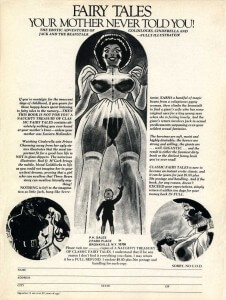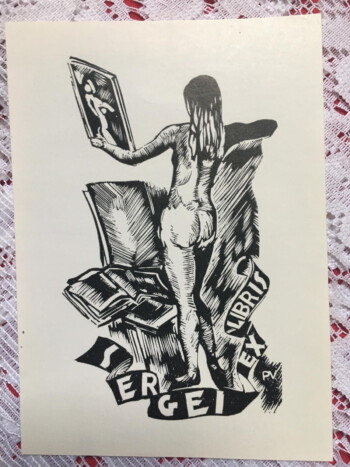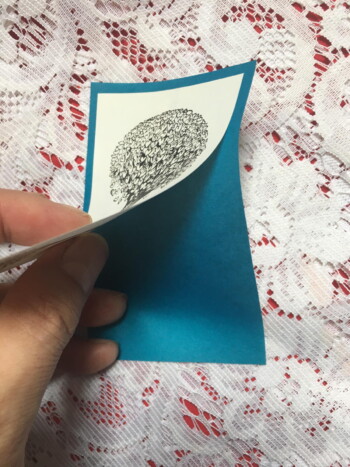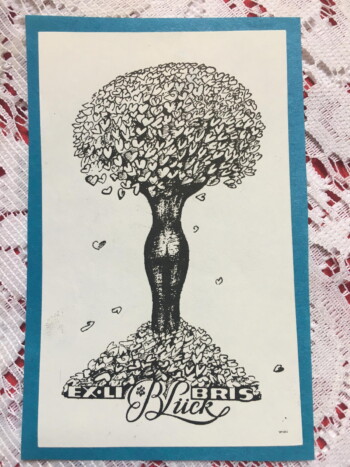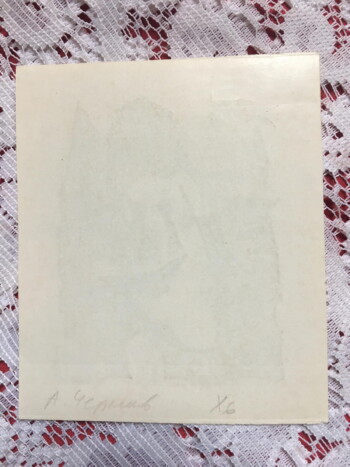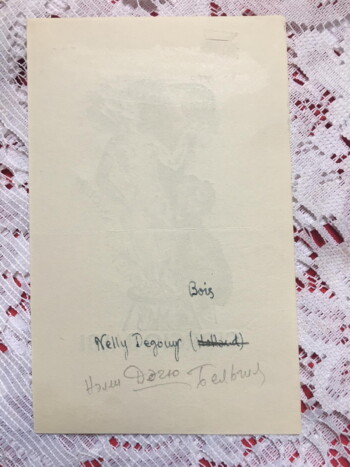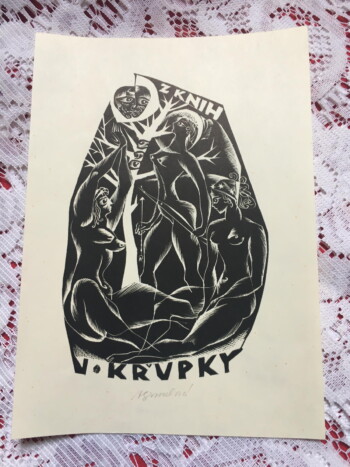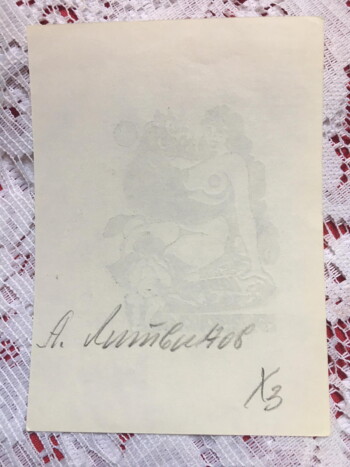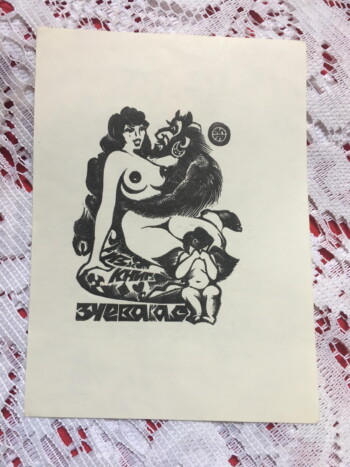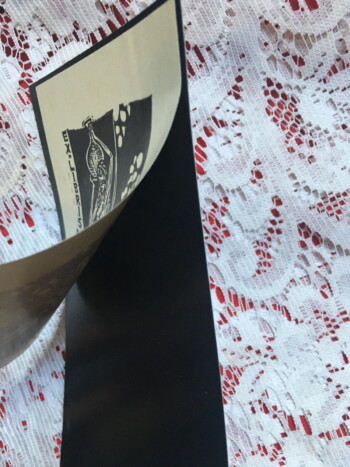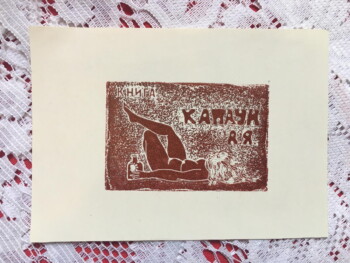-
 Blue Book Treasury of Classic Tails | Volume 1 | Goldilocks, "Translated from the Old Saxon and Illustrated by Sir Rod Q. M'Gurk, Knight of the Brush" (Classic Tails, Inc., 1972) 11" X 8.5", 32pp, soft covers, good condition, some minor bumping to corners & scuffing to covers, near fine internal pages. Blue Book Treasury of Classic Tails | Volume 2 | Jack and the Beanstalk, "Translated from the Old Saxon and Illustrated by Sir Rod Q. M'Gurk, Knight of the Brush" (Classic Tails, Inc., 1972) 11" X 8.5", 32pp, soft covers, just good condition, bumping to corners & scuffing/soiling to covers, near fine internal pages. Blue Book Treasury of Classic Tails | Volume 3 | Little Red Riding Hood, by Fud Dicksworth III (Classic Tails, Inc., 1972) 11" X 8.5", 32pp, soft covers, good+ condition, some bumping to corners, VERY rare. I've been able to find a few references to this book and very little about "Sir Rod Q. M'Gurk" or "Fud Dicksworth III". M'Gurk apparently also had his cartoons published in Swank magazine c. 1976-7. Eventually it came to the attention of some illustrators and (with help of former Disney animators) was made into a movie by Don Jurwich (not sure the connection between him and Sir Rod Q. M'Gurk, but I'd love to know if it was him).
Blue Book Treasury of Classic Tails | Volume 1 | Goldilocks, "Translated from the Old Saxon and Illustrated by Sir Rod Q. M'Gurk, Knight of the Brush" (Classic Tails, Inc., 1972) 11" X 8.5", 32pp, soft covers, good condition, some minor bumping to corners & scuffing to covers, near fine internal pages. Blue Book Treasury of Classic Tails | Volume 2 | Jack and the Beanstalk, "Translated from the Old Saxon and Illustrated by Sir Rod Q. M'Gurk, Knight of the Brush" (Classic Tails, Inc., 1972) 11" X 8.5", 32pp, soft covers, just good condition, bumping to corners & scuffing/soiling to covers, near fine internal pages. Blue Book Treasury of Classic Tails | Volume 3 | Little Red Riding Hood, by Fud Dicksworth III (Classic Tails, Inc., 1972) 11" X 8.5", 32pp, soft covers, good+ condition, some bumping to corners, VERY rare. I've been able to find a few references to this book and very little about "Sir Rod Q. M'Gurk" or "Fud Dicksworth III". M'Gurk apparently also had his cartoons published in Swank magazine c. 1976-7. Eventually it came to the attention of some illustrators and (with help of former Disney animators) was made into a movie by Don Jurwich (not sure the connection between him and Sir Rod Q. M'Gurk, but I'd love to know if it was him). -
 Manual of Classical Erotology (De figuris veneris), Fred. Chas. Forberg (stated Julian Smithson M. A., and friends, 1884 [later pirated edition]) 9.25"x6", hardcover 1/4 maroon over marbled boards, xiii-248pp, good condition This is a pirated edition (most likely 1920-30) of the first known English translation of this work. The original Julian Smithson edition was limited to 100 copies. De figuris Veneris (On the figures of Venus) was an anthology of ancient Greek and ancient Roman writings on erotic topics, discussed objectively and classified and grouped by subject matter. It was first published by the German classicist Friedrich Karl Forberg in 1824 in Latin and Greek as a commentary to Antonio Beccadelli's (1394-1471) Hermaphroditus (commonly referred to as Antonii Panormitae Hermaphroditus), an erotic poem sequence of 1425 in renaissance Latin, though it was later also published as a separate work. In 1899 Forberg's work was translated into English and published by Charles Carrington as De figuris Veneris, Manual of classical erotology, and again in 1907 by Charles Hirsch, and into French, German and Spanish. The French edition by Alcide Bonneau was titled Manuel d’érotologie classique. One French edition of 1906 was illustrated by Édouard-Henri Avril, which concludes with a list of 95 sexual positions. Most of the editions were restricted to high society or censored; one of the copies edited in France was immediately deposited on the secret shelves of the Bibliothèque nationale de France.
Manual of Classical Erotology (De figuris veneris), Fred. Chas. Forberg (stated Julian Smithson M. A., and friends, 1884 [later pirated edition]) 9.25"x6", hardcover 1/4 maroon over marbled boards, xiii-248pp, good condition This is a pirated edition (most likely 1920-30) of the first known English translation of this work. The original Julian Smithson edition was limited to 100 copies. De figuris Veneris (On the figures of Venus) was an anthology of ancient Greek and ancient Roman writings on erotic topics, discussed objectively and classified and grouped by subject matter. It was first published by the German classicist Friedrich Karl Forberg in 1824 in Latin and Greek as a commentary to Antonio Beccadelli's (1394-1471) Hermaphroditus (commonly referred to as Antonii Panormitae Hermaphroditus), an erotic poem sequence of 1425 in renaissance Latin, though it was later also published as a separate work. In 1899 Forberg's work was translated into English and published by Charles Carrington as De figuris Veneris, Manual of classical erotology, and again in 1907 by Charles Hirsch, and into French, German and Spanish. The French edition by Alcide Bonneau was titled Manuel d’érotologie classique. One French edition of 1906 was illustrated by Édouard-Henri Avril, which concludes with a list of 95 sexual positions. Most of the editions were restricted to high society or censored; one of the copies edited in France was immediately deposited on the secret shelves of the Bibliothèque nationale de France. -
 Aristophanes: Lysistrata, Aristophanes, illus. by Aubrey Beardsley (Beardsley Press, 1927, one of 750 unnumbered) 8.25″ x 11.5″, 99pp, quarter silver over black cloth, with silver and black patterned endpapers, black lettering to spine, good condition for age, bumping and scraping present, Beardsley’s prints are tipped in. Aristophanes was the greatest writer of ancient Athenian “old comedy,” known for its satires of contemporary life and for its broad, often obscene humor. Lysistrata was first produced in 411 BC, when the Peloponnesian War had been devastating Greece for 20 years. Most people know the plot: Lysistrata assembles women from all of Greece, and they agree that they will not have sex until the men make peace. Aubrey Beardsley was the greatest and the most controversial Art Nouveau illustrator in England, famous for his illustrations of Mallory’s Morte d’Arthur, Oscar Wilde’s Salome, Pope’s The Rape of the Lock, and for several magazines. Because he was associated with Oscar Wilde, Beardsley lost his job as art editor of a magazine named The Yellow Book in 1895, soon after Wilde was arrested for homosexuality. He was approached by Leonard Smithers, a publisher of erotic books, who asked him to illustrate Lysistrata. His illustrations are very much in the spirit of Aristophanes, as funny as they are obscene. Beardsley converted to Catholicism in 1897, and soon after, he asked Smithers to “destroy all copies of Lysistrata” with its “obscene drawings,” but Smithers refused. Beardsley died of tuberculosis in 1898, at the age of 26. Smithers initially published Lysistrata in a limited edition of one hundred copies. It was occasionally reprinted in very small runs, usually clandestinely, often poorly, but copies have long been scarce and expensive. Few copies of Beardsley’s Lysistrata printed before 1966 are currently in circulation. This copy is a rare limited edition printed by the Beardsley Press, London and even rarer with the binding intact.
Aristophanes: Lysistrata, Aristophanes, illus. by Aubrey Beardsley (Beardsley Press, 1927, one of 750 unnumbered) 8.25″ x 11.5″, 99pp, quarter silver over black cloth, with silver and black patterned endpapers, black lettering to spine, good condition for age, bumping and scraping present, Beardsley’s prints are tipped in. Aristophanes was the greatest writer of ancient Athenian “old comedy,” known for its satires of contemporary life and for its broad, often obscene humor. Lysistrata was first produced in 411 BC, when the Peloponnesian War had been devastating Greece for 20 years. Most people know the plot: Lysistrata assembles women from all of Greece, and they agree that they will not have sex until the men make peace. Aubrey Beardsley was the greatest and the most controversial Art Nouveau illustrator in England, famous for his illustrations of Mallory’s Morte d’Arthur, Oscar Wilde’s Salome, Pope’s The Rape of the Lock, and for several magazines. Because he was associated with Oscar Wilde, Beardsley lost his job as art editor of a magazine named The Yellow Book in 1895, soon after Wilde was arrested for homosexuality. He was approached by Leonard Smithers, a publisher of erotic books, who asked him to illustrate Lysistrata. His illustrations are very much in the spirit of Aristophanes, as funny as they are obscene. Beardsley converted to Catholicism in 1897, and soon after, he asked Smithers to “destroy all copies of Lysistrata” with its “obscene drawings,” but Smithers refused. Beardsley died of tuberculosis in 1898, at the age of 26. Smithers initially published Lysistrata in a limited edition of one hundred copies. It was occasionally reprinted in very small runs, usually clandestinely, often poorly, but copies have long been scarce and expensive. Few copies of Beardsley’s Lysistrata printed before 1966 are currently in circulation. This copy is a rare limited edition printed by the Beardsley Press, London and even rarer with the binding intact. -
 The Golden Ass of Apuleius, Lucius Apuleius Madaurensis (124-170 AD), trans. & intro Francis D. Byrne (The Imperial Press[Charles Carrington?], London, n.d. [1904?]) 8.25" X 6.25", xlix+588pp., hardbound, blue cloth boards with paper label on spine, top edge gilt, other edges deckled, just good condition, tearing to top of spine, no illustrations present. The Metamorphoses of Apuleius, which St. Augustine referred to as “The Golden Ass”, is the only Ancient Roman novel in Latin to survive in its entirety. The plot Lucius and his curiosity and insatiable desire to see and practice magic. While trying to perform a spell to transform into a bird, he is accidentally transformed into an ass. This leads to a long journey, literal and metaphorical, filled with in-set tales. He finally finds salvation through the intervention of the goddess Isis, whose cult he joins. The date of the original work is uncertain. Scholars are not sure if he wrote it in his youth or at the end of his life. He adapted the story from a Greek story written by Lucius of Patrae, however his original Greek text has long been lost.
The Golden Ass of Apuleius, Lucius Apuleius Madaurensis (124-170 AD), trans. & intro Francis D. Byrne (The Imperial Press[Charles Carrington?], London, n.d. [1904?]) 8.25" X 6.25", xlix+588pp., hardbound, blue cloth boards with paper label on spine, top edge gilt, other edges deckled, just good condition, tearing to top of spine, no illustrations present. The Metamorphoses of Apuleius, which St. Augustine referred to as “The Golden Ass”, is the only Ancient Roman novel in Latin to survive in its entirety. The plot Lucius and his curiosity and insatiable desire to see and practice magic. While trying to perform a spell to transform into a bird, he is accidentally transformed into an ass. This leads to a long journey, literal and metaphorical, filled with in-set tales. He finally finds salvation through the intervention of the goddess Isis, whose cult he joins. The date of the original work is uncertain. Scholars are not sure if he wrote it in his youth or at the end of his life. He adapted the story from a Greek story written by Lucius of Patrae, however his original Greek text has long been lost. -
 Your Sex Life | Before Marriage, Bob Hoffman (Strength & Health Publishing Co.,York, PA, 1939, first edition, third printing) 7.75" X 5.75", 206pp, hard bound blue cloth, just good condition, rubbing to boards, internal pages yellowing but good. Robert Collins Hoffman (1898 - 1985) was an American entrepreneur who rose to prominence as the owner of York Barbell. He founded magazines such as Muscular Development and Strength & Health, and was the manufacturer of a line of bodybuilding supplements. Hoffman promoted bodybuilders like John Grimek and Sigmund Klein, coached the American Olympic Weightlifting Team between 1936 and 1968, and was a founding member of the President's Council on Physical Fitness and Sports. This is a very rare copy of Hoffman book about premarital sex.
Your Sex Life | Before Marriage, Bob Hoffman (Strength & Health Publishing Co.,York, PA, 1939, first edition, third printing) 7.75" X 5.75", 206pp, hard bound blue cloth, just good condition, rubbing to boards, internal pages yellowing but good. Robert Collins Hoffman (1898 - 1985) was an American entrepreneur who rose to prominence as the owner of York Barbell. He founded magazines such as Muscular Development and Strength & Health, and was the manufacturer of a line of bodybuilding supplements. Hoffman promoted bodybuilders like John Grimek and Sigmund Klein, coached the American Olympic Weightlifting Team between 1936 and 1968, and was a founding member of the President's Council on Physical Fitness and Sports. This is a very rare copy of Hoffman book about premarital sex. -
 Julie, ou J'ai sauvé ma rose, Madame de C*** [Félicité Choiseul-Meuse] (Se trouve chez tous les Libraires Anglais, 1882) 8" x 5.25", 2 vol. bound together, 166pp 183pp, half calf on marbled boards, original wraps bound within, red label with gilt titles on spine, just good condition, boards intact, binding good, ribbon intact, major scuffing and bumping to the spine and rubbing to the boards. Felicite de Choiseul-Meuse wrote approximately twenty-seven novels from 1797 to 1824. Writings are sometimes identified by pseudonyms and acronyms: LFDLC; Emilia P ***, Madame de C *** , etc.. Her 1807 novel "Julie, ou j'ai sauvé ma rose" [Julie, or I saved my rose] is widely considered the first erotic novel written by a woman. It is more appropriately translated as "how I kept my cherry" for it tells the tale of a young woman who lets her lovers fondle her all they want, but will not allow penetration until she finds the right man and marries him. The work was condemned as obscene and its destruction ordered by the Cour royale de Paris on August 5, 1828. Excerpt: "I tasted in his arms unspeakable pleasures. Deadened by pleasure, then revived by an even more delirious pleasure, I made the object of happiness almost as happy as I was myself; and yet, true to my system, I made sure that he did not harvest the rose."
Julie, ou J'ai sauvé ma rose, Madame de C*** [Félicité Choiseul-Meuse] (Se trouve chez tous les Libraires Anglais, 1882) 8" x 5.25", 2 vol. bound together, 166pp 183pp, half calf on marbled boards, original wraps bound within, red label with gilt titles on spine, just good condition, boards intact, binding good, ribbon intact, major scuffing and bumping to the spine and rubbing to the boards. Felicite de Choiseul-Meuse wrote approximately twenty-seven novels from 1797 to 1824. Writings are sometimes identified by pseudonyms and acronyms: LFDLC; Emilia P ***, Madame de C *** , etc.. Her 1807 novel "Julie, ou j'ai sauvé ma rose" [Julie, or I saved my rose] is widely considered the first erotic novel written by a woman. It is more appropriately translated as "how I kept my cherry" for it tells the tale of a young woman who lets her lovers fondle her all they want, but will not allow penetration until she finds the right man and marries him. The work was condemned as obscene and its destruction ordered by the Cour royale de Paris on August 5, 1828. Excerpt: "I tasted in his arms unspeakable pleasures. Deadened by pleasure, then revived by an even more delirious pleasure, I made the object of happiness almost as happy as I was myself; and yet, true to my system, I made sure that he did not harvest the rose." -
 Julie, ou J'ai sauvé ma rose, Madame de C*** [Félicité Choiseul-Meuse] (J.-J. Gay, Bruxelles, 1882) 8" x 5.25", 2 vol. 169pp 188pp, full mottled calf, marbled endpapers. Gilt lettering and decorations on spine, 5 raised bands. 2 frontispiece engravings. just Fair condition, interior good, exterior in poor shape, Vol. 1 boards loose, Vol. 2 boards detached. Felicite de Choiseul-Meuse wrote approximately twenty-seven novels from 1797 to 1824. Writings are sometimes identified by pseudonyms and acronyms: LFDLC; Emilia P ***, Madame de C *** , etc.. Her 1807 novel "Julie, ou j'ai sauvé ma rose" [Julie, or I saved my rose] is widely considered the first erotic novel written by a woman. It is more appropriately translated as "how I kept my cherry" for it tells the tale of a young woman who lets her lovers fondle her all they want, but will not allow penetration until she finds the right man and marries him. The work was condemned as obscene and its destruction ordered by the Cour royale de Paris on August 5, 1828. Excerpt: "I tasted in his arms unspeakable pleasures. Deadened by pleasure, then revived by an even more delirious pleasure, I made the object of happiness almost as happy as I was myself; and yet, true to my system, I made sure that he did not harvest the rose."
Julie, ou J'ai sauvé ma rose, Madame de C*** [Félicité Choiseul-Meuse] (J.-J. Gay, Bruxelles, 1882) 8" x 5.25", 2 vol. 169pp 188pp, full mottled calf, marbled endpapers. Gilt lettering and decorations on spine, 5 raised bands. 2 frontispiece engravings. just Fair condition, interior good, exterior in poor shape, Vol. 1 boards loose, Vol. 2 boards detached. Felicite de Choiseul-Meuse wrote approximately twenty-seven novels from 1797 to 1824. Writings are sometimes identified by pseudonyms and acronyms: LFDLC; Emilia P ***, Madame de C *** , etc.. Her 1807 novel "Julie, ou j'ai sauvé ma rose" [Julie, or I saved my rose] is widely considered the first erotic novel written by a woman. It is more appropriately translated as "how I kept my cherry" for it tells the tale of a young woman who lets her lovers fondle her all they want, but will not allow penetration until she finds the right man and marries him. The work was condemned as obscene and its destruction ordered by the Cour royale de Paris on August 5, 1828. Excerpt: "I tasted in his arms unspeakable pleasures. Deadened by pleasure, then revived by an even more delirious pleasure, I made the object of happiness almost as happy as I was myself; and yet, true to my system, I made sure that he did not harvest the rose." -
 Private Hours of Napoleon Bonaparte | from his earliest years to the period of his marriage with the Arch-Duchess Maria Louisa | written by himself during his residence in the island of Elba, (Printed for Germain Mathiot, Paris, 1816, reverse title page says "London: Printed by Schulze and Dean") 7" X 5", 4 vols., 240pp 247pp 248pp 240pp, rebound in 1/2 brown calf over marbled boards, 5 raised bands and gilt titles on spine, blindstamp designs on leather, marbled edges, good+ condition, rare book This was not at all written by Napoleon but written anonymously. The story (unverified) is that it was commissioned by the publisher Henry Colburn (1784-1855) for British intelligence with the primarily erotic or otherwise scandalous content intended to discredit Napoleon's character while he was in exile in Elba. This is a very rare work. Only a few copies located worldwide. The only other one I've found in the US is in Harvard's library. This work was also published in French (with a London imprint).
Private Hours of Napoleon Bonaparte | from his earliest years to the period of his marriage with the Arch-Duchess Maria Louisa | written by himself during his residence in the island of Elba, (Printed for Germain Mathiot, Paris, 1816, reverse title page says "London: Printed by Schulze and Dean") 7" X 5", 4 vols., 240pp 247pp 248pp 240pp, rebound in 1/2 brown calf over marbled boards, 5 raised bands and gilt titles on spine, blindstamp designs on leather, marbled edges, good+ condition, rare book This was not at all written by Napoleon but written anonymously. The story (unverified) is that it was commissioned by the publisher Henry Colburn (1784-1855) for British intelligence with the primarily erotic or otherwise scandalous content intended to discredit Napoleon's character while he was in exile in Elba. This is a very rare work. Only a few copies located worldwide. The only other one I've found in the US is in Harvard's library. This work was also published in French (with a London imprint). -
 Napoleon et les Femmes | L 'amour, Frederick Masson, illus. A. Calbet (Librairie Borel, Paris, 1899 "Collection Nymphée") 7.5" X 3.75", 391pp.+, 3/4 blue leather over marbled blue silk-covered boards, 5 raised bands, top edge gilt, marbled end-papers, illustrations throughout This book focuses on the life of women under the Consulate and the Empire. It considers Napoleon’s conception of women, examining his contribution to the drafting of the Civil Code on the question of the place of women in society or the education of young girls. The memoirs and correspondence give an idea of how the women who lived through the Empire perceived this period of reforms, deprivation of freedoms, and also wars.
Napoleon et les Femmes | L 'amour, Frederick Masson, illus. A. Calbet (Librairie Borel, Paris, 1899 "Collection Nymphée") 7.5" X 3.75", 391pp.+, 3/4 blue leather over marbled blue silk-covered boards, 5 raised bands, top edge gilt, marbled end-papers, illustrations throughout This book focuses on the life of women under the Consulate and the Empire. It considers Napoleon’s conception of women, examining his contribution to the drafting of the Civil Code on the question of the place of women in society or the education of young girls. The memoirs and correspondence give an idea of how the women who lived through the Empire perceived this period of reforms, deprivation of freedoms, and also wars. -
 Ninety-Five Limericks | A Contribution to the Folk Lore of our Time | Collected and Edited by John Falmouth (The Limerick Press, Suffern, NY, 1932) 5"x7.25", unpaginated, protected DJ over tan cloth boards with red lettering and decorations, tears and soiling to DJ, some soiling on boards, interior good, previous owner added a limerick about a young man from Calcutta in the end pages. Mr. Falmouth has a 6 page forward where he discusses the phallic nature of the limerick (with diagrams). A fun little book even though the profanity is exed out.
Ninety-Five Limericks | A Contribution to the Folk Lore of our Time | Collected and Edited by John Falmouth (The Limerick Press, Suffern, NY, 1932) 5"x7.25", unpaginated, protected DJ over tan cloth boards with red lettering and decorations, tears and soiling to DJ, some soiling on boards, interior good, previous owner added a limerick about a young man from Calcutta in the end pages. Mr. Falmouth has a 6 page forward where he discusses the phallic nature of the limerick (with diagrams). A fun little book even though the profanity is exed out. -
 Memoirs of Cardinal Dubois | A complete unabridged translation from the French by Ernest Dowson | Embellished with photogravure portraits of Cardinal Dubois and the Duc d'Orleans, together with twelve full page drawings by Lui Trugo (Privately Printed for Subscribers [Art Studio Press], New York, 1929, #261/1500) 9.75"x6.5", 2 volumes on hand laid paper, xvi-376pp, viii-349pp, DJ over black cloth with gilt titles and decorations, top-edge inked, others deckled, good+ condition, few small tears to DJ, internally fine. According to the publisher, the original manuscript which was written entirely in Dubois hand was stolen by his secretary Lavergne after his death in 1723. It was later discovered of its literary value that Lavergne attempted to sell the manuscript. He was found and arrested. They later fell into the hands of Comte de Maurepas, then upon his death they were passed on to an anonymous writer named Mercier (possibly M. Paul Laroix) whose family had it published in 1829. The manuscript then became lost. In 1899 and English version of the book translated by Ernest Christopher Dowson, was published by the notorious pornographer, Leonard Smithers & Co. This is, presumably a reprinting of that translation. Guillaume Dubois (1656-1723), a son of a country doctor, rose from humble beginnings to positions of power and high honor in government and in the Catholic Church. He is best known for negotiating the Triple Alliance of 1717 between France, the Dutch Republic and Great Britain against their mutual enemy, Spain. Considered one of the four great French Cardinal-Ministers (Richelieu, Mazarin, Dubois, and Fleury). His ecclesiastical career left a great deal to be desired. Although there is no proof of the prevalent assertion that he got secretly married, his licentiousness, and notorious impiety, even at the time of his death, make it evident that he pursued and used ecclesiastical dignities principally to enhance his political position and prestige. Eventually in 1721, Du Bois was created cardinal. He had the reputation of a libertine and adventurer and made plenty of enemies. One of his rivals was charged at creating his portrait, the Duc de Saint-Simon, who was said to have placed a painting of Dubois in his lavatory. Saint-Simon had this to say about the Cardinal: "He was a little, pitiful, wizened, herring-gutted man, in a flaxen wig, with a weasel's face, brightened by some intellect. All the vices - perfidy, avarice, debauchery, ambition, flattery - fought within him for the mastery. He was so consummate a liar that, when taken in the fact, he could brazenly deny it. Even his wit and knowledge of the world were spoiled, and his affected gaiety was touched with sadness, by the odour of falsehood which escaped through every pore of his body." This famous picture is certainly biased. Dubois was unscrupulous, but so were his contemporaries, and whatever vices he had, he forged a European peace that, with the exception of small, restrained military expeditions against the Austrian Habsburgs, would last for a quarter of a century.
Memoirs of Cardinal Dubois | A complete unabridged translation from the French by Ernest Dowson | Embellished with photogravure portraits of Cardinal Dubois and the Duc d'Orleans, together with twelve full page drawings by Lui Trugo (Privately Printed for Subscribers [Art Studio Press], New York, 1929, #261/1500) 9.75"x6.5", 2 volumes on hand laid paper, xvi-376pp, viii-349pp, DJ over black cloth with gilt titles and decorations, top-edge inked, others deckled, good+ condition, few small tears to DJ, internally fine. According to the publisher, the original manuscript which was written entirely in Dubois hand was stolen by his secretary Lavergne after his death in 1723. It was later discovered of its literary value that Lavergne attempted to sell the manuscript. He was found and arrested. They later fell into the hands of Comte de Maurepas, then upon his death they were passed on to an anonymous writer named Mercier (possibly M. Paul Laroix) whose family had it published in 1829. The manuscript then became lost. In 1899 and English version of the book translated by Ernest Christopher Dowson, was published by the notorious pornographer, Leonard Smithers & Co. This is, presumably a reprinting of that translation. Guillaume Dubois (1656-1723), a son of a country doctor, rose from humble beginnings to positions of power and high honor in government and in the Catholic Church. He is best known for negotiating the Triple Alliance of 1717 between France, the Dutch Republic and Great Britain against their mutual enemy, Spain. Considered one of the four great French Cardinal-Ministers (Richelieu, Mazarin, Dubois, and Fleury). His ecclesiastical career left a great deal to be desired. Although there is no proof of the prevalent assertion that he got secretly married, his licentiousness, and notorious impiety, even at the time of his death, make it evident that he pursued and used ecclesiastical dignities principally to enhance his political position and prestige. Eventually in 1721, Du Bois was created cardinal. He had the reputation of a libertine and adventurer and made plenty of enemies. One of his rivals was charged at creating his portrait, the Duc de Saint-Simon, who was said to have placed a painting of Dubois in his lavatory. Saint-Simon had this to say about the Cardinal: "He was a little, pitiful, wizened, herring-gutted man, in a flaxen wig, with a weasel's face, brightened by some intellect. All the vices - perfidy, avarice, debauchery, ambition, flattery - fought within him for the mastery. He was so consummate a liar that, when taken in the fact, he could brazenly deny it. Even his wit and knowledge of the world were spoiled, and his affected gaiety was touched with sadness, by the odour of falsehood which escaped through every pore of his body." This famous picture is certainly biased. Dubois was unscrupulous, but so were his contemporaries, and whatever vices he had, he forged a European peace that, with the exception of small, restrained military expeditions against the Austrian Habsburgs, would last for a quarter of a century. -
Out of stock
 Memoirs of Cardinal Dubois | translated from the French by Ernest Dowson | with photogravure portraits of Cardinal Dubois and the Duc d'Orleans (Leonard Smithers and Co, London, 1899, First Edition thus, first English translation) 9.75"x6.5", 2 volumes, xvi-282pp, viii-268pp, blue boards with gilt decoration and titles on spine, deckled edges, good condition, bumping to corners, bookplates for Reginald Dalton Pontifex in both volumes. According to the publisher, the original manuscript which was written entirely in Dubois hand was stolen by his secretary Lavergne after his death in 1723. It was later discovered of its literary value that Lavergne attempted to sell the manuscript. He was found and arrested. They later fell into the hands of Comte de Maurepas, then upon his death they were passed on to an anonymous writer named Mercier (possibly M. Paul Laroix) whose family had it published in 1829. The manuscript then became lost. In 1899 and English version of the book translated by Ernest Christopher Dowson, was published by the notorious pornographer, Leonard Smithers & Co. This is, presumably a reprinting of that translation. Guillaume Dubois (1656-1723), a son of a country doctor, rose from humble beginnings to positions of power and high honor in government and in the Catholic Church. He is best known for negotiating the Triple Alliance of 1717 between France, the Dutch Republic and Great Britain against their mutual enemy, Spain. Considered one of the four great French Cardinal-Ministers (Richelieu, Mazarin, Dubois, and Fleury). His ecclesiastical career left a great deal to be desired. Although there is no proof of the prevalent assertion that he got secretly married, his licentiousness, and notorious impiety, even at the time of his death, make it evident that he pursued and used ecclesiastical dignities principally to enhance his political position and prestige. Eventually in 1721, Du Bois was created cardinal. He had the reputation of a libertine and adventurer and made plenty of enemies. One of his rivals was charged at creating his portrait, the Duc de Saint-Simon, who was said to have placed a painting of Dubois in his lavatory. Saint-Simon had this to say about the Cardinal: "He was a little, pitiful, wizened, herring-gutted man, in a flaxen wig, with a weasel's face, brightened by some intellect. All the vices - perfidy, avarice, debauchery, ambition, flattery - fought within him for the mastery. He was so consummate a liar that, when taken in the fact, he could brazenly deny it. Even his wit and knowledge of the world were spoiled, and his affected gaiety was touched with sadness, by the odour of falsehood which escaped through every pore of his body." This famous picture is certainly biased. Dubois was unscrupulous, but so were his contemporaries, and whatever vices he had, he forged a European peace that, with the exception of small, restrained military expeditions against the Austrian Habsburgs, would last for a quarter of a century. Leonard Smithers (1861-1907), a solicitor born in Sheffield, was one of the most notable publishers of erotica of his day. He was said to be a brilliant but shady character who operated on the fringes of the rare book trade, issuing small, clandestine editions of risqué books with the boast: 'I will publish the things the others are afraid to touch'. He was notorious for posting a slogan at his bookshop in Bond Street reading "Smut is cheap today". He developed a friendship with Sir Richard Francis Burton and published Burton's famous translation of the Book of One Thousand and One Nights in 1885. He also worked with, among others, Aubrey Beardsley, Aleister Crowley, and Oscar Wilde. With Beardsley and Arthur Symons, he founded The Savoy, a periodical which ran for eight issues in 1896. Smithers famously partnered with Harry Nichols to publish a series of pornographic books under the Erotika Biblion Society imprint. When Beardsley, on his death bed, converted to Catholicism and asked Smithers to “destroy all copies of Lysistrata and bad drawings...by all that is holy all obscene drawings.", Smithers, famously and thankfully ignored him and continued to publish his works until his death in 1907. It was Smithers who published Oscar Wilde's The Ballad of Reading Gaol, a long poem commemorating the harsh rhythms of prison life in 1898. Smithers went bankrupt in 1900 and died impoverished in 1907 from cirrhosis of the liver. Up until his death he continued to sell reproductions (and forgeries) of Beardsley's work as well as reproductions of the Beardsley's letter asking him to destroy his drawings. Reginald Dalton Pontifex (1857–1951) was born in France, attended Magdalen College at Oxford from 1876–80, getting a Fourth in Law in 1880 and a Third in his BCL in 1882. He later practiced as a barrister. At the time of his death it was said he had quite the book collection containing, several of antiquarian interest. He bequethed his book collection to his alma mater. Most of his books were printed in the early nineteenth century and many of them extensively illustrated. He died in Bournemouth, Hampshire, England in 1951.
Memoirs of Cardinal Dubois | translated from the French by Ernest Dowson | with photogravure portraits of Cardinal Dubois and the Duc d'Orleans (Leonard Smithers and Co, London, 1899, First Edition thus, first English translation) 9.75"x6.5", 2 volumes, xvi-282pp, viii-268pp, blue boards with gilt decoration and titles on spine, deckled edges, good condition, bumping to corners, bookplates for Reginald Dalton Pontifex in both volumes. According to the publisher, the original manuscript which was written entirely in Dubois hand was stolen by his secretary Lavergne after his death in 1723. It was later discovered of its literary value that Lavergne attempted to sell the manuscript. He was found and arrested. They later fell into the hands of Comte de Maurepas, then upon his death they were passed on to an anonymous writer named Mercier (possibly M. Paul Laroix) whose family had it published in 1829. The manuscript then became lost. In 1899 and English version of the book translated by Ernest Christopher Dowson, was published by the notorious pornographer, Leonard Smithers & Co. This is, presumably a reprinting of that translation. Guillaume Dubois (1656-1723), a son of a country doctor, rose from humble beginnings to positions of power and high honor in government and in the Catholic Church. He is best known for negotiating the Triple Alliance of 1717 between France, the Dutch Republic and Great Britain against their mutual enemy, Spain. Considered one of the four great French Cardinal-Ministers (Richelieu, Mazarin, Dubois, and Fleury). His ecclesiastical career left a great deal to be desired. Although there is no proof of the prevalent assertion that he got secretly married, his licentiousness, and notorious impiety, even at the time of his death, make it evident that he pursued and used ecclesiastical dignities principally to enhance his political position and prestige. Eventually in 1721, Du Bois was created cardinal. He had the reputation of a libertine and adventurer and made plenty of enemies. One of his rivals was charged at creating his portrait, the Duc de Saint-Simon, who was said to have placed a painting of Dubois in his lavatory. Saint-Simon had this to say about the Cardinal: "He was a little, pitiful, wizened, herring-gutted man, in a flaxen wig, with a weasel's face, brightened by some intellect. All the vices - perfidy, avarice, debauchery, ambition, flattery - fought within him for the mastery. He was so consummate a liar that, when taken in the fact, he could brazenly deny it. Even his wit and knowledge of the world were spoiled, and his affected gaiety was touched with sadness, by the odour of falsehood which escaped through every pore of his body." This famous picture is certainly biased. Dubois was unscrupulous, but so were his contemporaries, and whatever vices he had, he forged a European peace that, with the exception of small, restrained military expeditions against the Austrian Habsburgs, would last for a quarter of a century. Leonard Smithers (1861-1907), a solicitor born in Sheffield, was one of the most notable publishers of erotica of his day. He was said to be a brilliant but shady character who operated on the fringes of the rare book trade, issuing small, clandestine editions of risqué books with the boast: 'I will publish the things the others are afraid to touch'. He was notorious for posting a slogan at his bookshop in Bond Street reading "Smut is cheap today". He developed a friendship with Sir Richard Francis Burton and published Burton's famous translation of the Book of One Thousand and One Nights in 1885. He also worked with, among others, Aubrey Beardsley, Aleister Crowley, and Oscar Wilde. With Beardsley and Arthur Symons, he founded The Savoy, a periodical which ran for eight issues in 1896. Smithers famously partnered with Harry Nichols to publish a series of pornographic books under the Erotika Biblion Society imprint. When Beardsley, on his death bed, converted to Catholicism and asked Smithers to “destroy all copies of Lysistrata and bad drawings...by all that is holy all obscene drawings.", Smithers, famously and thankfully ignored him and continued to publish his works until his death in 1907. It was Smithers who published Oscar Wilde's The Ballad of Reading Gaol, a long poem commemorating the harsh rhythms of prison life in 1898. Smithers went bankrupt in 1900 and died impoverished in 1907 from cirrhosis of the liver. Up until his death he continued to sell reproductions (and forgeries) of Beardsley's work as well as reproductions of the Beardsley's letter asking him to destroy his drawings. Reginald Dalton Pontifex (1857–1951) was born in France, attended Magdalen College at Oxford from 1876–80, getting a Fourth in Law in 1880 and a Third in his BCL in 1882. He later practiced as a barrister. At the time of his death it was said he had quite the book collection containing, several of antiquarian interest. He bequethed his book collection to his alma mater. Most of his books were printed in the early nineteenth century and many of them extensively illustrated. He died in Bournemouth, Hampshire, England in 1951. -
 Memoirs of Cardinal Dubois | translated from the French by Ernest Dowson | with photogravure portraits of Cardinal Dubois and the Duc d'Orleans (Leonard Smithers and Co, London, 1899, First Edition thus, first English translation) 9.75"x6.5", 2 volumes, xvi-282pp, viii-268pp, blue boards with gilt decoration and titles on spine, deckled edges, good condition, bumping to corners, bookplates for Reginald Dalton Pontifex in both volumes. According to the publisher, the original manuscript which was written entirely in Dubois hand was stolen by his secretary Lavergne after his death in 1723. It was later discovered of its literary value that Lavergne attempted to sell the manuscript. He was found and arrested. They later fell into the hands of Comte de Maurepas, then upon his death they were passed on to an anonymous writer named Mercier (possibly M. Paul Laroix) whose family had it published in 1829. The manuscript then became lost. In 1899 and English version of the book translated by Ernest Christopher Dowson, was published by the notorious pornographer, Leonard Smithers & Co. This is, presumably a reprinting of that translation. Guillaume Dubois (1656-1723), a son of a country doctor, rose from humble beginnings to positions of power and high honor in government and in the Catholic Church. He is best known for negotiating the Triple Alliance of 1717 between France, the Dutch Republic and Great Britain against their mutual enemy, Spain. Considered one of the four great French Cardinal-Ministers (Richelieu, Mazarin, Dubois, and Fleury). His ecclesiastical career left a great deal to be desired. Although there is no proof of the prevalent assertion that he got secretly married, his licentiousness, and notorious impiety, even at the time of his death, make it evident that he pursued and used ecclesiastical dignities principally to enhance his political position and prestige. Eventually in 1721, Du Bois was created cardinal. He had the reputation of a libertine and adventurer and made plenty of enemies. One of his rivals was charged at creating his portrait, the Duc de Saint-Simon, who was said to have placed a painting of Dubois in his lavatory. Saint-Simon had this to say about the Cardinal: "He was a little, pitiful, wizened, herring-gutted man, in a flaxen wig, with a weasel's face, brightened by some intellect. All the vices - perfidy, avarice, debauchery, ambition, flattery - fought within him for the mastery. He was so consummate a liar that, when taken in the fact, he could brazenly deny it. Even his wit and knowledge of the world were spoiled, and his affected gaiety was touched with sadness, by the odour of falsehood which escaped through every pore of his body." This famous picture is certainly biased. Dubois was unscrupulous, but so were his contemporaries, and whatever vices he had, he forged a European peace that, with the exception of small, restrained military expeditions against the Austrian Habsburgs, would last for a quarter of a century. Leonard Smithers (1861-1907), a solicitor born in Sheffield, was one of the most notable publishers of erotica of his day. He was said to be a brilliant but shady character who operated on the fringes of the rare book trade, issuing small, clandestine editions of risqué books with the boast: 'I will publish the things the others are afraid to touch'. He was notorious for posting a slogan at his bookshop in Bond Street reading "Smut is cheap today". He developed a friendship with Sir Richard Francis Burton and published Burton's famous translation of the Book of One Thousand and One Nights in 1885. He also worked with, among others, Aubrey Beardsley, Aleister Crowley, and Oscar Wilde. With Beardsley and Arthur Symons, he founded The Savoy, a periodical which ran for eight issues in 1896. Smithers famously partnered with Harry Nichols to publish a series of pornographic books under the Erotika Biblion Society imprint. When Beardsley, on his death bed, converted to Catholicism and asked Smithers to “destroy all copies of Lysistrata and bad drawings...by all that is holy all obscene drawings.", Smithers, famously and thankfully ignored him and continued to publish his works until his death in 1907. It was Smithers who published Oscar Wilde's The Ballad of Reading Gaol, a long poem commemorating the harsh rhythms of prison life in 1898. Smithers went bankrupt in 1900 and died impoverished in 1907 from cirrhosis of the liver. Up until his death he continued to sell reproductions (and forgeries) of Beardsley's work as well as reproductions of the Beardsley's letter asking him to destroy his drawings. Reginald Dalton Pontifex (1857–1951) was born in France, attended Magdalen College at Oxford from 1876–80, getting a Fourth in Law in 1880 and a Third in his BCL in 1882. He later practiced as a barrister. At the time of his death it was said he had quite the book collection containing, several of antiquarian interest. He bequethed his book collection to his alma mater. Most of his books were printed in the early nineteenth century and many of them extensively illustrated. He died in Bournemouth, Hampshire, England in 1951.
Memoirs of Cardinal Dubois | translated from the French by Ernest Dowson | with photogravure portraits of Cardinal Dubois and the Duc d'Orleans (Leonard Smithers and Co, London, 1899, First Edition thus, first English translation) 9.75"x6.5", 2 volumes, xvi-282pp, viii-268pp, blue boards with gilt decoration and titles on spine, deckled edges, good condition, bumping to corners, bookplates for Reginald Dalton Pontifex in both volumes. According to the publisher, the original manuscript which was written entirely in Dubois hand was stolen by his secretary Lavergne after his death in 1723. It was later discovered of its literary value that Lavergne attempted to sell the manuscript. He was found and arrested. They later fell into the hands of Comte de Maurepas, then upon his death they were passed on to an anonymous writer named Mercier (possibly M. Paul Laroix) whose family had it published in 1829. The manuscript then became lost. In 1899 and English version of the book translated by Ernest Christopher Dowson, was published by the notorious pornographer, Leonard Smithers & Co. This is, presumably a reprinting of that translation. Guillaume Dubois (1656-1723), a son of a country doctor, rose from humble beginnings to positions of power and high honor in government and in the Catholic Church. He is best known for negotiating the Triple Alliance of 1717 between France, the Dutch Republic and Great Britain against their mutual enemy, Spain. Considered one of the four great French Cardinal-Ministers (Richelieu, Mazarin, Dubois, and Fleury). His ecclesiastical career left a great deal to be desired. Although there is no proof of the prevalent assertion that he got secretly married, his licentiousness, and notorious impiety, even at the time of his death, make it evident that he pursued and used ecclesiastical dignities principally to enhance his political position and prestige. Eventually in 1721, Du Bois was created cardinal. He had the reputation of a libertine and adventurer and made plenty of enemies. One of his rivals was charged at creating his portrait, the Duc de Saint-Simon, who was said to have placed a painting of Dubois in his lavatory. Saint-Simon had this to say about the Cardinal: "He was a little, pitiful, wizened, herring-gutted man, in a flaxen wig, with a weasel's face, brightened by some intellect. All the vices - perfidy, avarice, debauchery, ambition, flattery - fought within him for the mastery. He was so consummate a liar that, when taken in the fact, he could brazenly deny it. Even his wit and knowledge of the world were spoiled, and his affected gaiety was touched with sadness, by the odour of falsehood which escaped through every pore of his body." This famous picture is certainly biased. Dubois was unscrupulous, but so were his contemporaries, and whatever vices he had, he forged a European peace that, with the exception of small, restrained military expeditions against the Austrian Habsburgs, would last for a quarter of a century. Leonard Smithers (1861-1907), a solicitor born in Sheffield, was one of the most notable publishers of erotica of his day. He was said to be a brilliant but shady character who operated on the fringes of the rare book trade, issuing small, clandestine editions of risqué books with the boast: 'I will publish the things the others are afraid to touch'. He was notorious for posting a slogan at his bookshop in Bond Street reading "Smut is cheap today". He developed a friendship with Sir Richard Francis Burton and published Burton's famous translation of the Book of One Thousand and One Nights in 1885. He also worked with, among others, Aubrey Beardsley, Aleister Crowley, and Oscar Wilde. With Beardsley and Arthur Symons, he founded The Savoy, a periodical which ran for eight issues in 1896. Smithers famously partnered with Harry Nichols to publish a series of pornographic books under the Erotika Biblion Society imprint. When Beardsley, on his death bed, converted to Catholicism and asked Smithers to “destroy all copies of Lysistrata and bad drawings...by all that is holy all obscene drawings.", Smithers, famously and thankfully ignored him and continued to publish his works until his death in 1907. It was Smithers who published Oscar Wilde's The Ballad of Reading Gaol, a long poem commemorating the harsh rhythms of prison life in 1898. Smithers went bankrupt in 1900 and died impoverished in 1907 from cirrhosis of the liver. Up until his death he continued to sell reproductions (and forgeries) of Beardsley's work as well as reproductions of the Beardsley's letter asking him to destroy his drawings. Reginald Dalton Pontifex (1857–1951) was born in France, attended Magdalen College at Oxford from 1876–80, getting a Fourth in Law in 1880 and a Third in his BCL in 1882. He later practiced as a barrister. At the time of his death it was said he had quite the book collection containing, several of antiquarian interest. He bequethed his book collection to his alma mater. Most of his books were printed in the early nineteenth century and many of them extensively illustrated. He died in Bournemouth, Hampshire, England in 1951. -
 The Golden Ass of Apuleius, a new translation with introduction and notes by Francis D. Byrne, Lucius Apuleius Madaurensis (124-170 AD), trans. Francis D Byrne, illust. [20 etchings] Martin van Maele (Classical Translation Union, Privately Issued for the Subscribers [Charles Carrington], 1904, Paris, #304/750) 6" X 8", xlix+588pp, blue boards with gilt decorations and titles, top-edge gilt, others deckled, some light foxing in the first few pages, advertisements on last few pages (all Carrington works). The Metamorphoses of Apuleius, which St. Augustine referred to as “The Golden Ass”, is the only Ancient Roman novel in Latin to survive in its entirety. The plot Lucius and his curiosity and insatiable desire to see and practice magic. While trying to perform a spell to transform into a bird, he is accidentally transformed into an ass. This leads to a long journey, literal and metaphorical, filled with in-set tales. He finally finds salvation through the intervention of the goddess Isis, whose cult he joins. The date of the original work is uncertain. Scholars are not sure if he wrote it in his youth or at the end of his life. He adapted the story from a Greek story written by Lucius of Patrae, however his original Greek text has long been lost. Maurice François Alfred Martin van Miële (1863-5 – 1926), better known by his pseudonym Martin van Maële, was a French illustrator of early 20th century literature. Though he gained notoriety with his illustration for H. G. Wells in Les Premiers Hommes dans la Lune, and he worked as an illustrator for the Félix Juven’s French translations of the Sherlock Holmes series, he is now most widely renowned and mostly remembered for his erotic illustrations.
The Golden Ass of Apuleius, a new translation with introduction and notes by Francis D. Byrne, Lucius Apuleius Madaurensis (124-170 AD), trans. Francis D Byrne, illust. [20 etchings] Martin van Maele (Classical Translation Union, Privately Issued for the Subscribers [Charles Carrington], 1904, Paris, #304/750) 6" X 8", xlix+588pp, blue boards with gilt decorations and titles, top-edge gilt, others deckled, some light foxing in the first few pages, advertisements on last few pages (all Carrington works). The Metamorphoses of Apuleius, which St. Augustine referred to as “The Golden Ass”, is the only Ancient Roman novel in Latin to survive in its entirety. The plot Lucius and his curiosity and insatiable desire to see and practice magic. While trying to perform a spell to transform into a bird, he is accidentally transformed into an ass. This leads to a long journey, literal and metaphorical, filled with in-set tales. He finally finds salvation through the intervention of the goddess Isis, whose cult he joins. The date of the original work is uncertain. Scholars are not sure if he wrote it in his youth or at the end of his life. He adapted the story from a Greek story written by Lucius of Patrae, however his original Greek text has long been lost. Maurice François Alfred Martin van Miële (1863-5 – 1926), better known by his pseudonym Martin van Maële, was a French illustrator of early 20th century literature. Though he gained notoriety with his illustration for H. G. Wells in Les Premiers Hommes dans la Lune, and he worked as an illustrator for the Félix Juven’s French translations of the Sherlock Holmes series, he is now most widely renowned and mostly remembered for his erotic illustrations. -
 Les métamorphoses ou l’asne d’or de Luce Apulée philosophe platonique, Lucius Apuleius Madaurensis (124-170 AD), trans. Jules De Montlyald, preface by Jules de Marthold, illust. [21 etchings] Martin van Maele (Charles Carrington, Librairie-Éditeur, 1905, Paris, #115/750) 6.25" X 9.25", xlviii+328pp, beautifully bound in three-quarter morocco over marbled boards with gilt titles and decorations on the spine, top-edge gilt, others uncut, fine condition overall, 21 full-page tipped-in B/W engravings with tissue guards and numerous in-text illustrations by Martin van Meale, red ribbon intact. The Metamorphoses of Apuleius, which St. Augustine referred to as “The Golden Ass”, is the only Ancient Roman novel in Latin to survive in its entirety. The plot Lucius and his curiosity and insatiable desire to see and practice magic. While trying to perform a spell to transform into a bird, he is accidentally transformed into an ass. This leads to a long journey, literal and metaphorical, filled with in-set tales. He finally finds salvation through the intervention of the goddess Isis, whose cult he joins. The date of the original work is uncertain. Scholars are not sure if he wrote it in his youth or at the end of his life. He adapted the story from a Greek story written by Lucius of Patrae, however his original Greek text has long been lost. Maurice François Alfred Martin van Miële (1863-5 – 1926), better known by his pseudonym Martin van Maële, was a French illustrator of early 20th century literature. Though he gained notoriety with his illustration for H. G. Wells in Les Premiers Hommes dans la Lune, and he worked as an illustrator for the Félix Juven’s French translations of the Sherlock Holmes series, he is now most widely renowned and mostly remembered for his erotic illustrations.
Les métamorphoses ou l’asne d’or de Luce Apulée philosophe platonique, Lucius Apuleius Madaurensis (124-170 AD), trans. Jules De Montlyald, preface by Jules de Marthold, illust. [21 etchings] Martin van Maele (Charles Carrington, Librairie-Éditeur, 1905, Paris, #115/750) 6.25" X 9.25", xlviii+328pp, beautifully bound in three-quarter morocco over marbled boards with gilt titles and decorations on the spine, top-edge gilt, others uncut, fine condition overall, 21 full-page tipped-in B/W engravings with tissue guards and numerous in-text illustrations by Martin van Meale, red ribbon intact. The Metamorphoses of Apuleius, which St. Augustine referred to as “The Golden Ass”, is the only Ancient Roman novel in Latin to survive in its entirety. The plot Lucius and his curiosity and insatiable desire to see and practice magic. While trying to perform a spell to transform into a bird, he is accidentally transformed into an ass. This leads to a long journey, literal and metaphorical, filled with in-set tales. He finally finds salvation through the intervention of the goddess Isis, whose cult he joins. The date of the original work is uncertain. Scholars are not sure if he wrote it in his youth or at the end of his life. He adapted the story from a Greek story written by Lucius of Patrae, however his original Greek text has long been lost. Maurice François Alfred Martin van Miële (1863-5 – 1926), better known by his pseudonym Martin van Maële, was a French illustrator of early 20th century literature. Though he gained notoriety with his illustration for H. G. Wells in Les Premiers Hommes dans la Lune, and he worked as an illustrator for the Félix Juven’s French translations of the Sherlock Holmes series, he is now most widely renowned and mostly remembered for his erotic illustrations. -
 The Ragionamenti or dialogues of the devine Pietro Aretino, Pietro Aretino, trans. Isidore Liseux (Isidore Liseux, Paris, 1889) 8.25" X 6", 6 volumes, xxxv+83pp, 89pp, 100pp, 134pp, 129pp, 138pp, original publishers paper wraps in just good condition with chipping at the top and bottom of the spine on some volumes, internal pages in mint condition, protective cover with green boards in fair condition, some joints loose and cloth peeling away, edges deckled, ex-libris of E. M. Schnadig Pietro Aretino (1492-1556) was one of the most important figures in Italian Renaissance literature, and certainly the most controversial. Condemned by some as a pornographer, his infamy was due largely to his use of explicit sexuality and the vulgar tongue of ordinary speech in much of his work. Dialogues center around a conversation between two rather frank, experienced, and sharp-tongued women on the topic of women’s occupations. We learn that at the time there were only three: wife, whore, or nun. Their discussion is a rollicking account of the advantages, perils, and pleasures each profession offers. Not only was Dialogues the first erotic book in the Christian world to be written in the common vernacular, it was but one of the few to describe the obscenity of commercial love, and is thus a cornerstone of both Italian literature and Counter-Renaissance vigour. First dialog: The Life of Nuns Second dialog: The Life of Married Women Third dialog: The Life of Courtesans Fourth dialog: The Education of Pippa Fifth dialog: The Wiles of Men Sixth dialog: The Bawd’s Trade Isidore Liseux (1835-1894) was a French bibliophile and publisher of erotica and curiosa. His publications were mostly rare texts of 16th to 18th century authors, hard to find and little known books which were usually translated and annotated by his friend and associate Alcide Bonneau or by Liseux himself. Liseux and Bonneau, both ex-priests, knew each other since seminary. His books were published in small numbers, on high quality paper, and with excellent typography. His usual printers were Claude Motteroz, Antoine Bécus, and later Charles Unsinger. Liseux’s books were published openly as the climate was more permissive in Paris at the time. His books were so well regarded that pirates of his books and even unrelated books bearing his imprint with a false date were published clandestinely into the 20th century. French poet, Guillaume Apollinaire wrote: “The publications of Liseux are more and more sought after because they are correct, beautiful and rare.” (Le flaneur des deux rives, 1918).
The Ragionamenti or dialogues of the devine Pietro Aretino, Pietro Aretino, trans. Isidore Liseux (Isidore Liseux, Paris, 1889) 8.25" X 6", 6 volumes, xxxv+83pp, 89pp, 100pp, 134pp, 129pp, 138pp, original publishers paper wraps in just good condition with chipping at the top and bottom of the spine on some volumes, internal pages in mint condition, protective cover with green boards in fair condition, some joints loose and cloth peeling away, edges deckled, ex-libris of E. M. Schnadig Pietro Aretino (1492-1556) was one of the most important figures in Italian Renaissance literature, and certainly the most controversial. Condemned by some as a pornographer, his infamy was due largely to his use of explicit sexuality and the vulgar tongue of ordinary speech in much of his work. Dialogues center around a conversation between two rather frank, experienced, and sharp-tongued women on the topic of women’s occupations. We learn that at the time there were only three: wife, whore, or nun. Their discussion is a rollicking account of the advantages, perils, and pleasures each profession offers. Not only was Dialogues the first erotic book in the Christian world to be written in the common vernacular, it was but one of the few to describe the obscenity of commercial love, and is thus a cornerstone of both Italian literature and Counter-Renaissance vigour. First dialog: The Life of Nuns Second dialog: The Life of Married Women Third dialog: The Life of Courtesans Fourth dialog: The Education of Pippa Fifth dialog: The Wiles of Men Sixth dialog: The Bawd’s Trade Isidore Liseux (1835-1894) was a French bibliophile and publisher of erotica and curiosa. His publications were mostly rare texts of 16th to 18th century authors, hard to find and little known books which were usually translated and annotated by his friend and associate Alcide Bonneau or by Liseux himself. Liseux and Bonneau, both ex-priests, knew each other since seminary. His books were published in small numbers, on high quality paper, and with excellent typography. His usual printers were Claude Motteroz, Antoine Bécus, and later Charles Unsinger. Liseux’s books were published openly as the climate was more permissive in Paris at the time. His books were so well regarded that pirates of his books and even unrelated books bearing his imprint with a false date were published clandestinely into the 20th century. French poet, Guillaume Apollinaire wrote: “The publications of Liseux are more and more sought after because they are correct, beautiful and rare.” (Le flaneur des deux rives, 1918). -
 The Dialogues of Luisa Sigea, Nicolas Chorier, translation by Isadore Liseux (Isadore Liseux, Paris, 1890, first edition, first English translation, printed by Ch. Unsinger) 8.75" X 5.75", 2nd and 3rd books of a 3 vol set, 132pp, 98+2pp, 3/4 crimson morocco over red boards, gilt decorations and titles on spine, top edge gilt, others deckled. Excellent condition for age, very minor bumping on corners and top and bottom of spine. In six dialogues (I. The skirmish; II. Tribadicon; III. Fabric; IV. The duel; V. Pleasures; VI. Frolics and sports) Tullia, who is 26, initiates her 15 year old cousin, Ottavia, in the art of sexual pleasure. The first four dialogues (not present), are fairly short, focus on tribadism and defloration. The longer fifth and six dialogues introduce flagellation, contractual submission, group sex, and anal sex. Like many sexual fictions, The Dialogues of Luisa Sigea (originally written in latin "Aloisiae Sigeae Satyra Sotadica de arcanis Amoris et Veneris") attempts to conceal the identity of its author: it purports to be based on a Latin manuscript translation of a work written originally in Spanish in the sixteenth century by an erudite young woman, Luisa Sigea of Toledo and translated into latin by Jean Meursius of Holland. In fact, it was written c. 1660, in latin, by a Frenchman, Nicolas Chorier (1612-1692), a lawyer who wrote works on various historical and philosophical subjects. The first first French translation, L’Academie des dames, was issued in the 1680. This 1890 edition was for the first time translated into English by Isidore Liseux and issued as a 3 volume set. (1. I-IV, 2. V, 3. VI). Vol 1 is missing from this set. Isidore Liseux (1835-1894) was a French bibliophile and publisher of erotica and curiosa. His publications were mostly rare texts of 16th to 18th century authors, hard to find and little known books which were usually translated and annotated by his friend and associate Alcide Bonneau or by Liseux himself. Liseux and Bonneau, both ex-priests, knew each other since seminary. His books were published in small numbers, on high quality paper, and with excellent typography. His usual printers were Claude Motteroz, Antoine Bécus, and later Charles Unsinger. Liseux's books were published openly as the climate was more permissive in Paris at the time. His books were so well regarded that pirates of his books and even unrelated books bearing his imprint with a false date were published clandestinely into the 20th century. French poet, Guillaume Apollinaire wrote: "The publications of Liseux are more and more sought after because they are correct, beautiful and rare." (Le flaneur des deux rives, 1918).
The Dialogues of Luisa Sigea, Nicolas Chorier, translation by Isadore Liseux (Isadore Liseux, Paris, 1890, first edition, first English translation, printed by Ch. Unsinger) 8.75" X 5.75", 2nd and 3rd books of a 3 vol set, 132pp, 98+2pp, 3/4 crimson morocco over red boards, gilt decorations and titles on spine, top edge gilt, others deckled. Excellent condition for age, very minor bumping on corners and top and bottom of spine. In six dialogues (I. The skirmish; II. Tribadicon; III. Fabric; IV. The duel; V. Pleasures; VI. Frolics and sports) Tullia, who is 26, initiates her 15 year old cousin, Ottavia, in the art of sexual pleasure. The first four dialogues (not present), are fairly short, focus on tribadism and defloration. The longer fifth and six dialogues introduce flagellation, contractual submission, group sex, and anal sex. Like many sexual fictions, The Dialogues of Luisa Sigea (originally written in latin "Aloisiae Sigeae Satyra Sotadica de arcanis Amoris et Veneris") attempts to conceal the identity of its author: it purports to be based on a Latin manuscript translation of a work written originally in Spanish in the sixteenth century by an erudite young woman, Luisa Sigea of Toledo and translated into latin by Jean Meursius of Holland. In fact, it was written c. 1660, in latin, by a Frenchman, Nicolas Chorier (1612-1692), a lawyer who wrote works on various historical and philosophical subjects. The first first French translation, L’Academie des dames, was issued in the 1680. This 1890 edition was for the first time translated into English by Isidore Liseux and issued as a 3 volume set. (1. I-IV, 2. V, 3. VI). Vol 1 is missing from this set. Isidore Liseux (1835-1894) was a French bibliophile and publisher of erotica and curiosa. His publications were mostly rare texts of 16th to 18th century authors, hard to find and little known books which were usually translated and annotated by his friend and associate Alcide Bonneau or by Liseux himself. Liseux and Bonneau, both ex-priests, knew each other since seminary. His books were published in small numbers, on high quality paper, and with excellent typography. His usual printers were Claude Motteroz, Antoine Bécus, and later Charles Unsinger. Liseux's books were published openly as the climate was more permissive in Paris at the time. His books were so well regarded that pirates of his books and even unrelated books bearing his imprint with a false date were published clandestinely into the 20th century. French poet, Guillaume Apollinaire wrote: "The publications of Liseux are more and more sought after because they are correct, beautiful and rare." (Le flaneur des deux rives, 1918). -
 The Dialogues of Luisa Sigea, Nicolas Chorier, translation by Isadore Liseux (Isadore Liseux, Paris, 1890, first edition, first English translation, printed by Ch. Unsinger) 8.75" X 5.75", 3 books bound in one, xx+87pp, 132pp, 98+2pp, 3/4 crimson morocco over red boards, 5 raised bands, gilt decorations and titles on spine, marbled endpapers, top edge gilt, others deckled. Excellent condition for age, very minor bumping on corners and top and bottom of spine. In six dialogues (I. The skirmish; II. Tribadicon; III. Fabric; IV. The duel; V. Pleasures; VI. Frolics and sports) Tullia, who is 26, initiates her 15 year old cousin, Ottavia, in the art of sexual pleasure. The first four dialogues, which are fairly short, focus on tribadism and defloration. The longer fifth and six dialogues introduce flagellation, contractual submission, group sex, and anal sex. Like many sexual fictions, The Dialogues of Luisa Sigea (originally written in latin "Aloisiae Sigeae Satyra Sotadica de arcanis Amoris et Veneris") attempts to conceal the identity of its author: it purports to be based on a Latin manuscript translation of a work written originally in Spanish in the sixteenth century by an erudite young woman, Luisa Sigea of Toledo and translated into latin by Jean Meursius of Holland. In fact, it was written c. 1660, in latin, by a Frenchman, Nicolas Chorier (1612-1692), a lawyer who wrote works on various historical and philosophical subjects. The first first French translation, L’Academie des dames, was issued in the 1680. This 1890 edition was for the first time translated into English by Isidore Liseux and issued as a 3 volume set. (1. I-IV, 2. V, 3. VI). Isidore Liseux (1835-1894) was a French bibliophile and publisher of erotica and curiosa. His publications were mostly rare texts of 16th to 18th century authors, hard to find and little known books which were usually translated and annotated by his friend and associate Alcide Bonneau or by Liseux himself. Liseux and Bonneau, both ex-priests, knew each other since seminary. His books were published in small numbers, on high quality paper, and with excellent typography. His usual printers were Claude Motteroz, Antoine Bécus, and later Charles Unsinger. Liseux's books were published openly as the climate was more permissive in Paris at the time. His books were so well regarded that pirates of his books and even unrelated books bearing his imprint with a false date were published clandestinely into the 20th century. French poet, Guillaume Apollinaire wrote: "The publications of Liseux are more and more sought after because they are correct, beautiful and rare." (Le flaneur des deux rives, 1918).
The Dialogues of Luisa Sigea, Nicolas Chorier, translation by Isadore Liseux (Isadore Liseux, Paris, 1890, first edition, first English translation, printed by Ch. Unsinger) 8.75" X 5.75", 3 books bound in one, xx+87pp, 132pp, 98+2pp, 3/4 crimson morocco over red boards, 5 raised bands, gilt decorations and titles on spine, marbled endpapers, top edge gilt, others deckled. Excellent condition for age, very minor bumping on corners and top and bottom of spine. In six dialogues (I. The skirmish; II. Tribadicon; III. Fabric; IV. The duel; V. Pleasures; VI. Frolics and sports) Tullia, who is 26, initiates her 15 year old cousin, Ottavia, in the art of sexual pleasure. The first four dialogues, which are fairly short, focus on tribadism and defloration. The longer fifth and six dialogues introduce flagellation, contractual submission, group sex, and anal sex. Like many sexual fictions, The Dialogues of Luisa Sigea (originally written in latin "Aloisiae Sigeae Satyra Sotadica de arcanis Amoris et Veneris") attempts to conceal the identity of its author: it purports to be based on a Latin manuscript translation of a work written originally in Spanish in the sixteenth century by an erudite young woman, Luisa Sigea of Toledo and translated into latin by Jean Meursius of Holland. In fact, it was written c. 1660, in latin, by a Frenchman, Nicolas Chorier (1612-1692), a lawyer who wrote works on various historical and philosophical subjects. The first first French translation, L’Academie des dames, was issued in the 1680. This 1890 edition was for the first time translated into English by Isidore Liseux and issued as a 3 volume set. (1. I-IV, 2. V, 3. VI). Isidore Liseux (1835-1894) was a French bibliophile and publisher of erotica and curiosa. His publications were mostly rare texts of 16th to 18th century authors, hard to find and little known books which were usually translated and annotated by his friend and associate Alcide Bonneau or by Liseux himself. Liseux and Bonneau, both ex-priests, knew each other since seminary. His books were published in small numbers, on high quality paper, and with excellent typography. His usual printers were Claude Motteroz, Antoine Bécus, and later Charles Unsinger. Liseux's books were published openly as the climate was more permissive in Paris at the time. His books were so well regarded that pirates of his books and even unrelated books bearing his imprint with a false date were published clandestinely into the 20th century. French poet, Guillaume Apollinaire wrote: "The publications of Liseux are more and more sought after because they are correct, beautiful and rare." (Le flaneur des deux rives, 1918). -
 Sappho: memoir, text, selected renderings, and a literal translation by Henry Thorton Wharton, Sappho, trans. Henry Thornton Wharton, M.A. Oxon. (John Lane [Bodley Head], London, A.C. McClurg & Co, Chicago, 1895 (third edition)) 7.25″ X 4.75″, xx 217pp + 16pp publisher’s list, hardbound, the third edition (this being the first to have its boards decorated by Aubrey Beardsley) green cloth boards with gilt decorations and titles on spine, bottom of the spine states “The Bodley Head and Chicago” reflecting the two publishing houses, top edge gilt, others deckled. Good condition for age, short tear on spine, binding and hinges good, newspaper article attached to back page “A Newly-Found Poem by Sappho” Sappho was a Greek lyric poet, born on the island of Lesbos. The Alexandrians included her in the list of nine lyric poets. Her birth was sometime between 630 and 612 BC, and it is said that she died around 570 BC, but little is known for certain about her life. The bulk of her poetry, which was well-known and greatly admired through much of antiquity, has been lost. But, her immense reputation has endured through surviving fragments. Sappho's poetry centers on passion and love for various people and both sexes. The word lesbian derives from the name of the island of her birth, Lesbos, while her name is also the origin of the word sapphic; neither word was applied to female homosexuality until the 19th century, after this translation by Wharton, the first English translation to acknowledge it. Originally John Lane and Elkin Mathews — The Bodley Head was a partnership set up in 1887 by John Lane (1854–1925) and Elkin Mathews (1851–1921), to trade in antiquarian books in London. It took its name from a bust of Sir Thomas Bodley, the eponymist of the Bodleian Library in Oxford, above the shop door. Lane and Mathews began in 1894 to publish works of ‘stylish decadence’, including the notorious literary periodical The Yellow Book. A. C. McClurg was a Chicago, Illinois based publisher made famous by their original publishing of the Tarzan of the Apes novels and other stories of Edgar Rice Burroughs.
Sappho: memoir, text, selected renderings, and a literal translation by Henry Thorton Wharton, Sappho, trans. Henry Thornton Wharton, M.A. Oxon. (John Lane [Bodley Head], London, A.C. McClurg & Co, Chicago, 1895 (third edition)) 7.25″ X 4.75″, xx 217pp + 16pp publisher’s list, hardbound, the third edition (this being the first to have its boards decorated by Aubrey Beardsley) green cloth boards with gilt decorations and titles on spine, bottom of the spine states “The Bodley Head and Chicago” reflecting the two publishing houses, top edge gilt, others deckled. Good condition for age, short tear on spine, binding and hinges good, newspaper article attached to back page “A Newly-Found Poem by Sappho” Sappho was a Greek lyric poet, born on the island of Lesbos. The Alexandrians included her in the list of nine lyric poets. Her birth was sometime between 630 and 612 BC, and it is said that she died around 570 BC, but little is known for certain about her life. The bulk of her poetry, which was well-known and greatly admired through much of antiquity, has been lost. But, her immense reputation has endured through surviving fragments. Sappho's poetry centers on passion and love for various people and both sexes. The word lesbian derives from the name of the island of her birth, Lesbos, while her name is also the origin of the word sapphic; neither word was applied to female homosexuality until the 19th century, after this translation by Wharton, the first English translation to acknowledge it. Originally John Lane and Elkin Mathews — The Bodley Head was a partnership set up in 1887 by John Lane (1854–1925) and Elkin Mathews (1851–1921), to trade in antiquarian books in London. It took its name from a bust of Sir Thomas Bodley, the eponymist of the Bodleian Library in Oxford, above the shop door. Lane and Mathews began in 1894 to publish works of ‘stylish decadence’, including the notorious literary periodical The Yellow Book. A. C. McClurg was a Chicago, Illinois based publisher made famous by their original publishing of the Tarzan of the Apes novels and other stories of Edgar Rice Burroughs. -
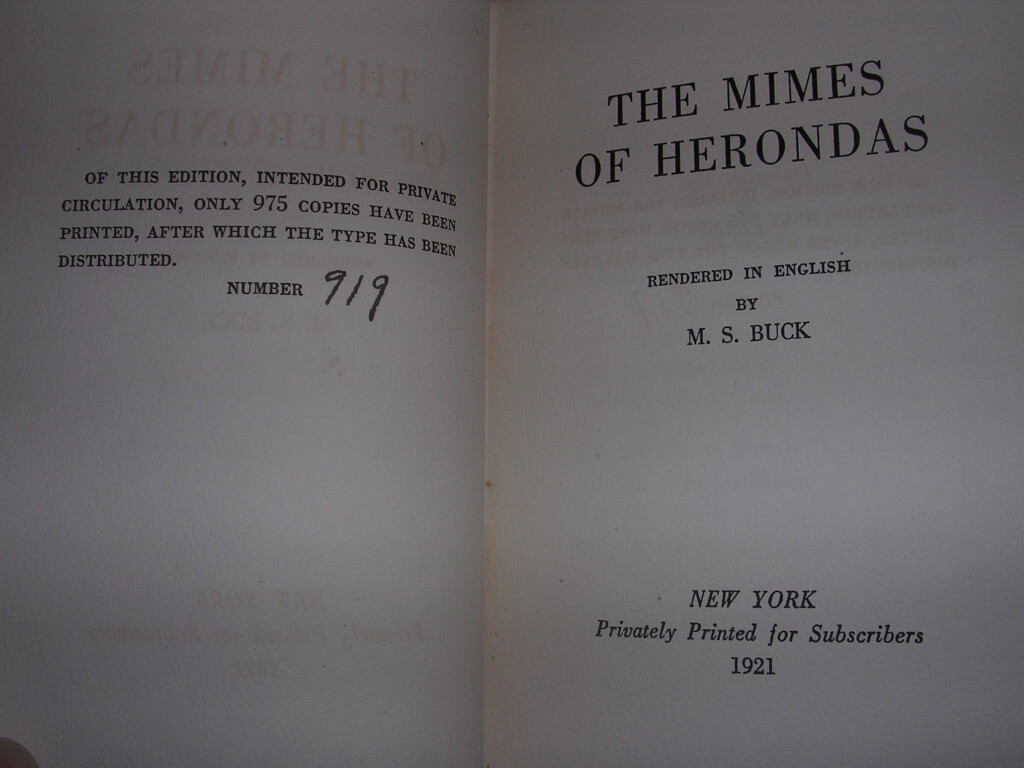
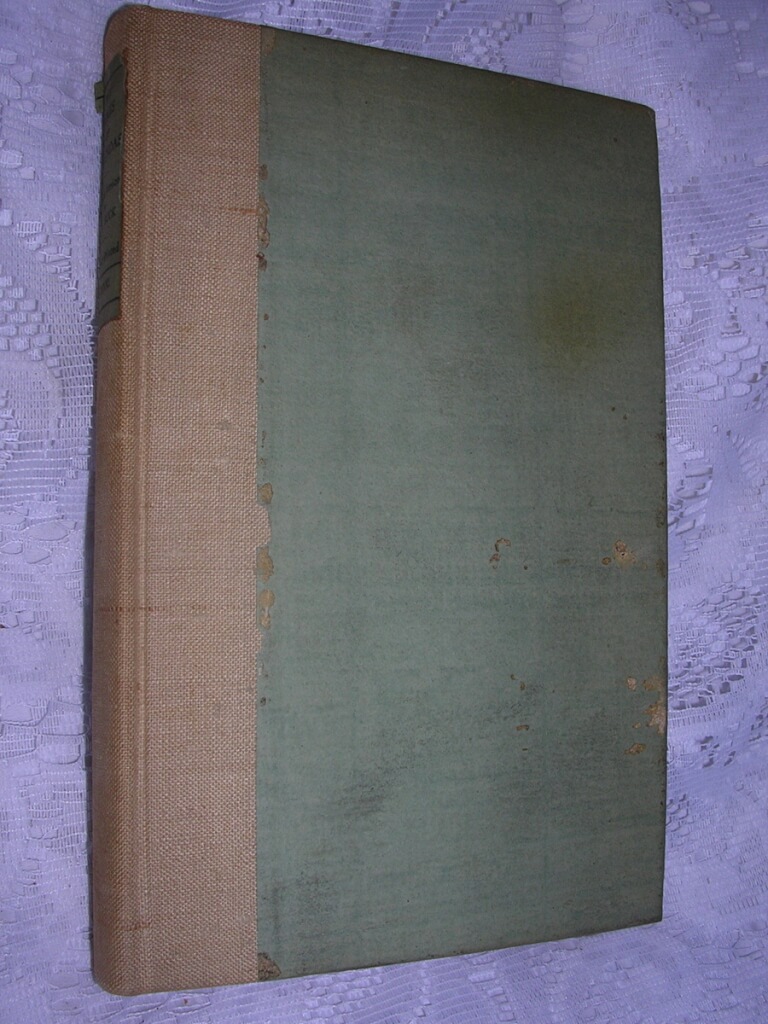 The Mimes of Herondas, trans. M. S. Buck (Privately Printed for Subscribers, New York, 1921, #919/975) 7" X 4 5/8", 119pp, hardbound no DJ, paper boards with beige cloth spine, top edge gilt, others deckle, good condition, lightly soiled Herodas was a Greek poet and the author of short humorous dramatic scenes in verse, written under the Alexandrian empire in the 3rd century BC. Mimes were scenes in popular life in South Italy and Sicily, written in the language of the people, vigorous with racy proverbs such as we get in other reflections of that region. The Mimes of Herodas have been known to us only since the discovery and publication of the "Kenyon", M. S. Buck, by the British Museum in 1891 (from a parchment containing 7 legible mimes half of the 8th and a fragment of the 9th).
The Mimes of Herondas, trans. M. S. Buck (Privately Printed for Subscribers, New York, 1921, #919/975) 7" X 4 5/8", 119pp, hardbound no DJ, paper boards with beige cloth spine, top edge gilt, others deckle, good condition, lightly soiled Herodas was a Greek poet and the author of short humorous dramatic scenes in verse, written under the Alexandrian empire in the 3rd century BC. Mimes were scenes in popular life in South Italy and Sicily, written in the language of the people, vigorous with racy proverbs such as we get in other reflections of that region. The Mimes of Herodas have been known to us only since the discovery and publication of the "Kenyon", M. S. Buck, by the British Museum in 1891 (from a parchment containing 7 legible mimes half of the 8th and a fragment of the 9th). -
 The Golden Ass of Apuleius, Lucius Apuleius Madaurensis (124-170 AD), trans. & intro Francis D. Byrne (The Imperial Press[Charles Carrington?], London, n.d. [1904?], #257/650) 7.75" X 5.75", xlix+388pp., 1/4 maroon morrocco over marbled boards with gilt titles and 4 raised bands on spine, top edge gilt The Metamorphoses of Apuleius, which St. Augustine referred to as “The Golden Ass”, is the only Ancient Roman novel in Latin to survive in its entirety. The plot Lucius and his curiosity and insatiable desire to see and practice magic. While trying to perform a spell to transform into a bird, he is accidentally transformed into an ass. This leads to a long journey, literal and metaphorical, filled with in-set tales. He finally finds salvation through the intervention of the goddess Isis, whose cult he joins. The date of the original work is uncertain. Scholars are not sure if he wrote it in his youth or at the end of his life. He adapted the story from a Greek story written by Lucius of Patrae, however his original Greek text has long been lost.
The Golden Ass of Apuleius, Lucius Apuleius Madaurensis (124-170 AD), trans. & intro Francis D. Byrne (The Imperial Press[Charles Carrington?], London, n.d. [1904?], #257/650) 7.75" X 5.75", xlix+388pp., 1/4 maroon morrocco over marbled boards with gilt titles and 4 raised bands on spine, top edge gilt The Metamorphoses of Apuleius, which St. Augustine referred to as “The Golden Ass”, is the only Ancient Roman novel in Latin to survive in its entirety. The plot Lucius and his curiosity and insatiable desire to see and practice magic. While trying to perform a spell to transform into a bird, he is accidentally transformed into an ass. This leads to a long journey, literal and metaphorical, filled with in-set tales. He finally finds salvation through the intervention of the goddess Isis, whose cult he joins. The date of the original work is uncertain. Scholars are not sure if he wrote it in his youth or at the end of his life. He adapted the story from a Greek story written by Lucius of Patrae, however his original Greek text has long been lost. -
 The Rahnghild Edition of: Venus in Furs, Leopold von Sacher-Masoch, illustrated by Rahnghild [Susan Inez Aguerra?] (William Faro, Inc [Samuel Roth, New York], 1932) 6.5"x9.25", 240pp, brown cloth boards with pasted title on spine, some soiling on front paste-down but overall a clean copy, beautiful art-deco illustrations throughout. Venus in Furs (German: Venus im Pelz) is a novella by Leopold Ritter von Sacher-Masoch (1836-1895), an Austrian writer and journalist. It is now his best known work and because of its themes the term masochism is derived from his name, coined by the Austrian psychiatrist, Krafft-Ebing. The novel was to be part of an epic series that Sacher-Masoch envisioned called Legacy of Cain. Venus in Furs was part of Love, the first volume of the series. It was published in 1870. The novel draws themes, like female dominance and sadomasochism, and character inspiration heavily from Sacher-Masoch’s own life. Wanda von Dunajew, the novel’s central female character, was modelled after his mistress Baroness Fanny Pistor. In December 1869 the two signed a contract making him her slave for a period of 6 months. In 1873, after the publication of Venus in Furs, Sacher-Masoch married Aurora von Rümelin who he pressured to continue the lifestyle he wrote about in his book. After 10 years they divorced. Rümelin, using the pseudonym of the books title character, “Wanda von Dunajew”, wrote Meine Lebensbeichte (My Life Confession) published in 1906. It detailed Sacher-Masoch’s private life and her relationship with him. During his lifetime, Sacher-Masoch was well known as a man of letters, a utopian thinker who espoused socialist and humanist ideals in his fiction and non-fiction. Most of his works remain untranslated into English. Until recently, his novel Venus in Furs was his only book commonly available in English. Samuel Roth (1893-1974) was an infamous American publisher and writer. He had a bookstore, Poetry Shop in the West Village section of Greenwich Villiage. He was the plaintiff in Roth v. United States (1957), which was a key Supreme Court ruling on freedom of sexual expression. He was also repeatedly convicted for publishing and distributing obscene material.
The Rahnghild Edition of: Venus in Furs, Leopold von Sacher-Masoch, illustrated by Rahnghild [Susan Inez Aguerra?] (William Faro, Inc [Samuel Roth, New York], 1932) 6.5"x9.25", 240pp, brown cloth boards with pasted title on spine, some soiling on front paste-down but overall a clean copy, beautiful art-deco illustrations throughout. Venus in Furs (German: Venus im Pelz) is a novella by Leopold Ritter von Sacher-Masoch (1836-1895), an Austrian writer and journalist. It is now his best known work and because of its themes the term masochism is derived from his name, coined by the Austrian psychiatrist, Krafft-Ebing. The novel was to be part of an epic series that Sacher-Masoch envisioned called Legacy of Cain. Venus in Furs was part of Love, the first volume of the series. It was published in 1870. The novel draws themes, like female dominance and sadomasochism, and character inspiration heavily from Sacher-Masoch’s own life. Wanda von Dunajew, the novel’s central female character, was modelled after his mistress Baroness Fanny Pistor. In December 1869 the two signed a contract making him her slave for a period of 6 months. In 1873, after the publication of Venus in Furs, Sacher-Masoch married Aurora von Rümelin who he pressured to continue the lifestyle he wrote about in his book. After 10 years they divorced. Rümelin, using the pseudonym of the books title character, “Wanda von Dunajew”, wrote Meine Lebensbeichte (My Life Confession) published in 1906. It detailed Sacher-Masoch’s private life and her relationship with him. During his lifetime, Sacher-Masoch was well known as a man of letters, a utopian thinker who espoused socialist and humanist ideals in his fiction and non-fiction. Most of his works remain untranslated into English. Until recently, his novel Venus in Furs was his only book commonly available in English. Samuel Roth (1893-1974) was an infamous American publisher and writer. He had a bookstore, Poetry Shop in the West Village section of Greenwich Villiage. He was the plaintiff in Roth v. United States (1957), which was a key Supreme Court ruling on freedom of sexual expression. He was also repeatedly convicted for publishing and distributing obscene material. -

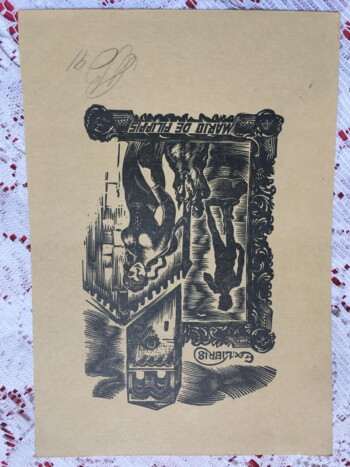 Ex Libris Mario de Filippis (signed) 5 x 4", signed on the front and back in pencil, presumably by artist Woman, man on horseback in front of Italian architecture and a silhouette of Michelangelo's David One of the most important (and largest) collections of ex libris in the world belongs to Mario De Filippis, the owner of Buca di San Francesco restaurant in Arezzo Italy. He has over 130,000 ex libris in his collection, approximately 13,000 are personal ex libris plates he's commissioned from artists all over the world using a multitude of printing techniques. His website describes Mario as "a passionate lover of small graphics".
Ex Libris Mario de Filippis (signed) 5 x 4", signed on the front and back in pencil, presumably by artist Woman, man on horseback in front of Italian architecture and a silhouette of Michelangelo's David One of the most important (and largest) collections of ex libris in the world belongs to Mario De Filippis, the owner of Buca di San Francesco restaurant in Arezzo Italy. He has over 130,000 ex libris in his collection, approximately 13,000 are personal ex libris plates he's commissioned from artists all over the world using a multitude of printing techniques. His website describes Mario as "a passionate lover of small graphics". -

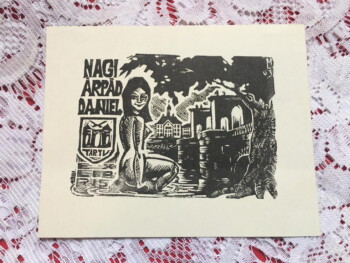 Ex Libris Nagi Arpad Daniel - Tartu 3.5 x 4.75", signed on the back, presumably by and for the Estonian artist, Arpad Daniel Nagy, Tartu is a city in Estonia nude woman sitting on rock in the water, behind her a bridge. Arpad Daniel Nagy was a creative visual artist. Arpad Daniel Nagy was born in 1922 and died in 1985. Arpad Daniel Nagy was largely inspired by the 1930s growing up. The period of the 1930s is characterised by the conflict between a number of political ideologies, including Marxist Socialism, Capitalist Democracy, and the Totalitarianism of both Communism and Fascism. Artistic output in the United States was heavily impacted at the time by the Great Depression, and a number of artists took to focusing on ideas of humility and the ordinary man. For the first time in US history, artists began to explore into political subjects and attempted to use their art to impact society. Themes such as poverty, lack of affordable housing, anti-lynching, anti-fascism, and workers' strikes were prevalent in many artists’ work. In the Soviet Union, Stalin’s government required urgent funds to implement the rapid industrialisation demanded by the first Five Year Plan. It initiated a secret plan to sell off treasures from the State Hermitage Museum in Leningrad (St. Petersburg), including a primary list of two hundred and fifty rare paintings by the Old Masters, many which found their way to the collection of Andrew Mellon via the New York based art dealing company, Knoedler. Surrealism continued to dominate in Europe, and had influence on an international scale. Artists such as Frida Kahlo and Diego Riviera in Mexico, worked to incorporate the ideas posed by Surrealism into their radical political ideologies, developing a new kind of magic realism. The decade took a ominous turn with the birth of National Socialism in Germany, followed by Adolf Hitler’s rise to power in 1933. By the end of the 1930s, the Second World War had begun; which preoccupied both artists and the global population.
Ex Libris Nagi Arpad Daniel - Tartu 3.5 x 4.75", signed on the back, presumably by and for the Estonian artist, Arpad Daniel Nagy, Tartu is a city in Estonia nude woman sitting on rock in the water, behind her a bridge. Arpad Daniel Nagy was a creative visual artist. Arpad Daniel Nagy was born in 1922 and died in 1985. Arpad Daniel Nagy was largely inspired by the 1930s growing up. The period of the 1930s is characterised by the conflict between a number of political ideologies, including Marxist Socialism, Capitalist Democracy, and the Totalitarianism of both Communism and Fascism. Artistic output in the United States was heavily impacted at the time by the Great Depression, and a number of artists took to focusing on ideas of humility and the ordinary man. For the first time in US history, artists began to explore into political subjects and attempted to use their art to impact society. Themes such as poverty, lack of affordable housing, anti-lynching, anti-fascism, and workers' strikes were prevalent in many artists’ work. In the Soviet Union, Stalin’s government required urgent funds to implement the rapid industrialisation demanded by the first Five Year Plan. It initiated a secret plan to sell off treasures from the State Hermitage Museum in Leningrad (St. Petersburg), including a primary list of two hundred and fifty rare paintings by the Old Masters, many which found their way to the collection of Andrew Mellon via the New York based art dealing company, Knoedler. Surrealism continued to dominate in Europe, and had influence on an international scale. Artists such as Frida Kahlo and Diego Riviera in Mexico, worked to incorporate the ideas posed by Surrealism into their radical political ideologies, developing a new kind of magic realism. The decade took a ominous turn with the birth of National Socialism in Germany, followed by Adolf Hitler’s rise to power in 1933. By the end of the 1930s, the Second World War had begun; which preoccupied both artists and the global population. -
Out of stock
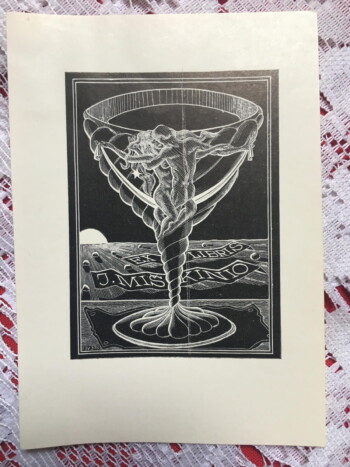 Ex libris J. Mikino 3 x 4", black ink on paper two lovers intertwined as a wine glass
Ex libris J. Mikino 3 x 4", black ink on paper two lovers intertwined as a wine glass -
Out of stock

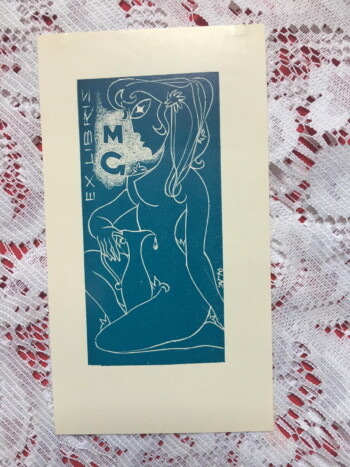 Ex Libris MG 2.75 x 5", unknown origin naked women with pitcher
Ex Libris MG 2.75 x 5", unknown origin naked women with pitcher -
Out of stock

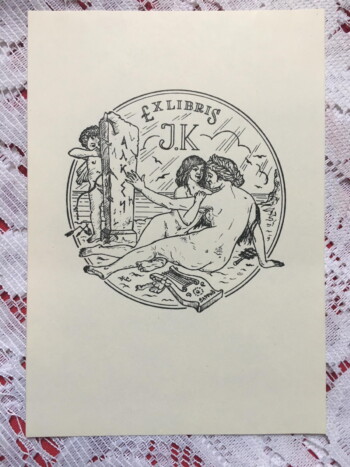 Ex Libris J.K 3.5 x 5", unknown origin, purchased from a collection in Italy naked women, a lyre labeled "Sappho", cupid behind pillar. Artist name written on back in pencil ("cangoo"?).
Ex Libris J.K 3.5 x 5", unknown origin, purchased from a collection in Italy naked women, a lyre labeled "Sappho", cupid behind pillar. Artist name written on back in pencil ("cangoo"?). -

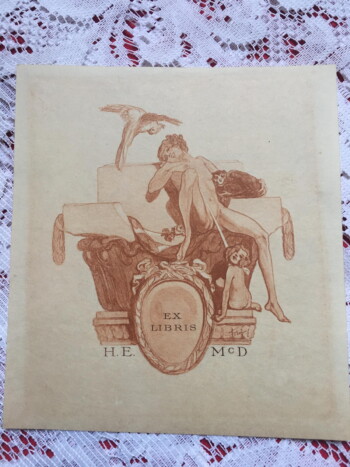 Ex Libris H.E. McD, by Franz von Bayros 4 x 4.5" red ink, previously pasted as evident by top part of back naked girl, animals, and child, presumably Ex libris for Horace E. McDonald Franz von Bayros (1866 – 1924) was an Austrian commercial artist, illustrator, and painter, now he is best known for his erotic work. He belonged to the Decadent movement in art, often utilizing erotic themes and phantasmagoric imagery. At the age 17, Bayros passed the entrance exam for the Vienna Academy with Eduard von Engerth. Bayros mixed in elegant society and soon belonged to the circle of friends of Johann Straub, whose step daughter Alice he married on 1896. The next year, Bayros moved to Munich. In 1904, Bayros gave his first exhibition in Munich, which was a great success. From 1904 until 1908, Bayros traveled to Paris and Italy for his studies. Typically, for an artist dealing with such imagery, von Bayros produced work under several pseudonyms, most notably Choisy Le Conin, and was hounded by authorities for much of his life for his “indecent” art often very imaginative, and including such taboo subjects as sadomasochism and bestiality. He became equally well-known for his masterly drawn figures of elegant modestly nude and non-nude women.
Ex Libris H.E. McD, by Franz von Bayros 4 x 4.5" red ink, previously pasted as evident by top part of back naked girl, animals, and child, presumably Ex libris for Horace E. McDonald Franz von Bayros (1866 – 1924) was an Austrian commercial artist, illustrator, and painter, now he is best known for his erotic work. He belonged to the Decadent movement in art, often utilizing erotic themes and phantasmagoric imagery. At the age 17, Bayros passed the entrance exam for the Vienna Academy with Eduard von Engerth. Bayros mixed in elegant society and soon belonged to the circle of friends of Johann Straub, whose step daughter Alice he married on 1896. The next year, Bayros moved to Munich. In 1904, Bayros gave his first exhibition in Munich, which was a great success. From 1904 until 1908, Bayros traveled to Paris and Italy for his studies. Typically, for an artist dealing with such imagery, von Bayros produced work under several pseudonyms, most notably Choisy Le Conin, and was hounded by authorities for much of his life for his “indecent” art often very imaginative, and including such taboo subjects as sadomasochism and bestiality. He became equally well-known for his masterly drawn figures of elegant modestly nude and non-nude women. -
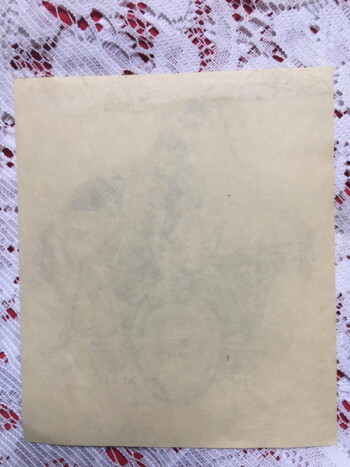
 Ex Libris H.E. McD, by Franz von Bayros 4 x 4.5" brown/black ink, previously pasted as evident by top part of back naked girl, animals, and child, presumably Ex libris for Horace E. McDonald Franz von Bayros (1866 – 1924) was an Austrian commercial artist, illustrator, and painter, now he is best known for his erotic work. He belonged to the Decadent movement in art, often utilizing erotic themes and phantasmagoric imagery. At the age 17, Bayros passed the entrance exam for the Vienna Academy with Eduard von Engerth. Bayros mixed in elegant society and soon belonged to the circle of friends of Johann Straub, whose step daughter Alice he married on 1896. The next year, Bayros moved to Munich. In 1904, Bayros gave his first exhibition in Munich, which was a great success. From 1904 until 1908, Bayros traveled to Paris and Italy for his studies. Typically, for an artist dealing with such imagery, von Bayros produced work under several pseudonyms, most notably Choisy Le Conin, and was hounded by authorities for much of his life for his “indecent” art often very imaginative, and including such taboo subjects as sadomasochism and bestiality. He became equally well-known for his masterly drawn figures of elegant modestly nude and non-nude women.
Ex Libris H.E. McD, by Franz von Bayros 4 x 4.5" brown/black ink, previously pasted as evident by top part of back naked girl, animals, and child, presumably Ex libris for Horace E. McDonald Franz von Bayros (1866 – 1924) was an Austrian commercial artist, illustrator, and painter, now he is best known for his erotic work. He belonged to the Decadent movement in art, often utilizing erotic themes and phantasmagoric imagery. At the age 17, Bayros passed the entrance exam for the Vienna Academy with Eduard von Engerth. Bayros mixed in elegant society and soon belonged to the circle of friends of Johann Straub, whose step daughter Alice he married on 1896. The next year, Bayros moved to Munich. In 1904, Bayros gave his first exhibition in Munich, which was a great success. From 1904 until 1908, Bayros traveled to Paris and Italy for his studies. Typically, for an artist dealing with such imagery, von Bayros produced work under several pseudonyms, most notably Choisy Le Conin, and was hounded by authorities for much of his life for his “indecent” art often very imaginative, and including such taboo subjects as sadomasochism and bestiality. He became equally well-known for his masterly drawn figures of elegant modestly nude and non-nude women.












